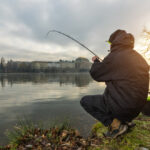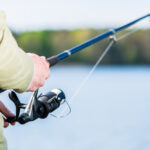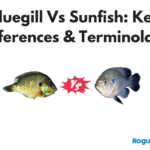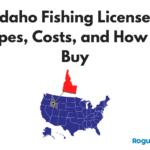Discovering the best kinds of fishing lines for bass in 2022 or any type of fish for that matter can be an arduous trial and error process if you don’t have any guidance. Refining your knowledge and techniques can take years but we’re here to help speed up the process.
To make matters worse, similar to top bass rod and reel combos, there are so many different lines on the market these days, and trawling through them for the right one for your specific application can feel overwhelming. If you pick the wrong one, you’ll learn a lesson, but you’ll be out of pocket and will have wasted a solid weekend’s fishing time.
In this post, we’ll review everything that goes into choosing the right fishing line for bass in 2022, including abrasion resistance, stretch, coating, braid, and memory. Here, we’ve composed an in-depth bass line guide as well as reviewed five of the best lines for bass fishing in the business.
Keep in mind, the right line is only part of your decision process, you’ll want a great spinning rod for bass, a well-made baitcasting reel for bass, and of course reliable buzzbait for bass.
OUR TOP PICK
KastKing SuperPower Braided Fishing Line
[5stars]

KK SuperPower line is one of the most versatile options for bass fishing on the market. Available in a vast array of tests to suit any scenario, the dynamically braided fibers facilitate a stronger knot, reducing the chance of a line break and your fish escaping.
It’s also a very low memory, sensitive line that responds to your every movement, allowing you to experiment and develop subtle techniques that other lines don’t allow.
Structurally speaking, this is an ultra-strong line with zero stretch, which is great for a confident hook setting.
Still, beginners might find it a little unforgiving, preferring something with a little more flexibility. The SuperPower’s strength makes it the perfect line for use in rocky streams and fast-current waters.
Possibly the best and certainly most unique thing about it is the proprietary treatment that reduces friction as it zooms through the guides, making your cast feel velvety smooth. You’ll enjoy hitting the water with this line even if you return empty-handed.
Pros
- High Abrasion Resistance – This line won’t snap on rocks and let your dream catch get away.
- Zero Stretch – No line stretch makes setting the hook easier for experienced anglers
- Slick Coating – Line treatment facilitates a smoother cast.
- Dynamic Braid – The way the fibers are braided allows for stronger knots, reducing the chance of a break and your fish escaping.
- Low Memory – It won’t pick up a curl from the spool and limit performance.
Cons
- Very Stiff – This line might be a bit rigid for beginners.
- Bleeding – The dyes can run on occasion when wet and stain fabrics.
EDITORS CHOICE
Berkley Trilene XL Smooth Casting Monofilament Fishing Line
[5stars]

Here we have something a little more suitable for beginners but no less capable of reeling in a big old bass!
It’s an exceedingly manageable line, giving burgeoning anglers more control as they refine their abilities. It’s also deceptively strong, and able to compete to a certain extent with small diameter braided lines.
Such is the strength of Trilene XL that it features very low memory for a monoline and casts in a buttery smooth fashion.
It’s also quite a sensitive line, very responsive to both your movement and strikes, ensuring you don’t miss a bite and allow the fish to swallow the hook, which can be a real pain to remove.
Available only as a translucent line, it’s not the most adventurous prospect, but if you’re just getting started, you shouldn’t worry too much about color. What’s important is honing your skills, and this line will help you do that.
Pros
- Strength – With similar strength as a braided line, it’s less likely to snap in the middle of a battle.
- Manageability – It’s easy to use, allowing new anglers to try different fishing styles and techniques.
- Price Tag – Awesome value for money line.
- Translucent – Low visibility ensures the line won’t spook bass.
Cons
- Low Abrasion Resistance – If this line snags on a rock, there’s a good chance it will break.
- Memory – Although this is a low memory line initially, it’s quite susceptible to kinking after a certain duration on the spool.
BEST VALUE
RUNCL PowerFluoro Fishing Line
[5stars]

The Powerfluoro is a hybrid line featuring a fluorocarbon exterior and a copolymer core, combining their properties into one super line.
The resilient fluorocarbon outer imbues it with abrasion resistance and shock integrity, while the copolymer brings some slinky flex to the table and reduces line memory.
This broad set of qualities makes it incredibly versatile and suitable for several environments, fish, and weather conditions. If you’re not yet sure what part location plays in line choice, there’s a good chance this line is well suited to most of your local hotspots.
It’s also very dense, making it the ideal choice for crank fishing, trying to pull in those large bass swimming in the deep. High density also helps stave off freezing, making the PowerFluoro a shoo-in for ice fishing.
Exhibiting a small amount of stretch, we see potential in this line acting as a bridge, helping you acclimatize to stiffer designs, easing away the training wheels, so to speak.
Pros
- Strength – This line can handle the force of sudden and powerful strikes.
- Hybrid Structure – Using two materials, you get a wider range of beneficial properties.
- High Density – Great for using sinkbait or punching mats, and it won’t freeze in frigid temperatures.
- High Sensitivity – You’ll notice even the most delicate nibbles.
Cons
- Line Memory – Not as resistant to memory as braided lines.
- No Colors – Translucent is your only option.
RUNNER UP
Power Pro Spectra Fiber Braided Fishing Line
[4stars]

Power Pro Spectra is one of the most durable lines you can buy. Spectra fiber, an ultra-high molecular weight polyethylene (UHMWP), is 15% stronger than steel and a fraction of the weight, so if you tire of bass and decide to hit the South Pacific in search of Godzilla, this is the line you’d need.
Despite this unparalleled strength, it manages to retain a miraculous level of sensitivity, so when that big one comes, you’re primed and ready to set the hook and reel it on in.
If you’ve got a particularly dense landscape to tackle, we highly recommend giving the Spectra a try but bear in mind, that this is a strictly zero-stretch line, so it might take some getting used to.
Pros
- Super Strength – Spectra fiber construction means there’s very little chance of breakage.
- Thin Diameter – Can be purchased in a very thin diameter for a braided line which is fantastic for casting large dead bait.
- Manageability – very easy to maneuver, giving you an edge on the water.
Cons
- No Stretch – You have to be confident in your abilities before taking this line for a test drive.
- Less to a Spool – You only get 150 yards per spool, which isn’t a lot comparatively speaking.
RUNNER UP
Daiwa J-Braid 8 Strand Woven Round Braided Fishing Line
[4stars]

J-Braid is a formidable braided line made in Japan woven with eight high-quality fibers ensuring a rounded profile on an almost molecular level. This is fantastic as a smooth, round line reduces friction as you cast, allowing you to hit greater distances.
It goes without saying that more fibers increase the strength of a line. Still, the use of 8 brings both durability and softness that vastly increases sensitivity, eliminating the irritating guesswork that comes part and parcel with large diameter, high strength lines.
J-Braid 8 is also highly resistant to wind knotting, a snarling of the line that occurs when an overrun of slackline slips free of the spinning reel. These are almost impossible to untangle, can catch on line guides, and waste line length.
Thanks to such a dense braid, this line has spectacular abrasion resistance, making it a good choice for fishing in rocky areas or waters with lots of grass and hidden obstacles.
Pros
- Smooth Profile – The eight braided fabrics make for a rounder, smoother sailing line.
- High Strength and Abrasion Resistant – There’s very little chance of this line snapping, even if there are some particularly frictional rocks about.
- Resist Wind Knots – Say goodbye to those wasteful snares and enjoy the full length of your wire.
- Chartreuse Coloring – Great for use with floating baits as you can see the line clearly against the surface of the water.
Cons
- Bright Coloring – When deep fishing, it may be noticeable to fish.
- Not ColorFast – Some of the darker colors tend to run a little.
Best Fishing Line for Bass Buying Guide
You can certainly exhibit a knack for the act of fishing itself, but talent can only take you so far. Fishing, like anything, requires more than raw talent. To set yourself aside from the pack, you need dedication and a thirst for knowledge.
As such, learning about the different kinds of lines and how they’re best utilized will ensure you’re a cut above the average. Let’s begin by discussing the three most popular types of line.
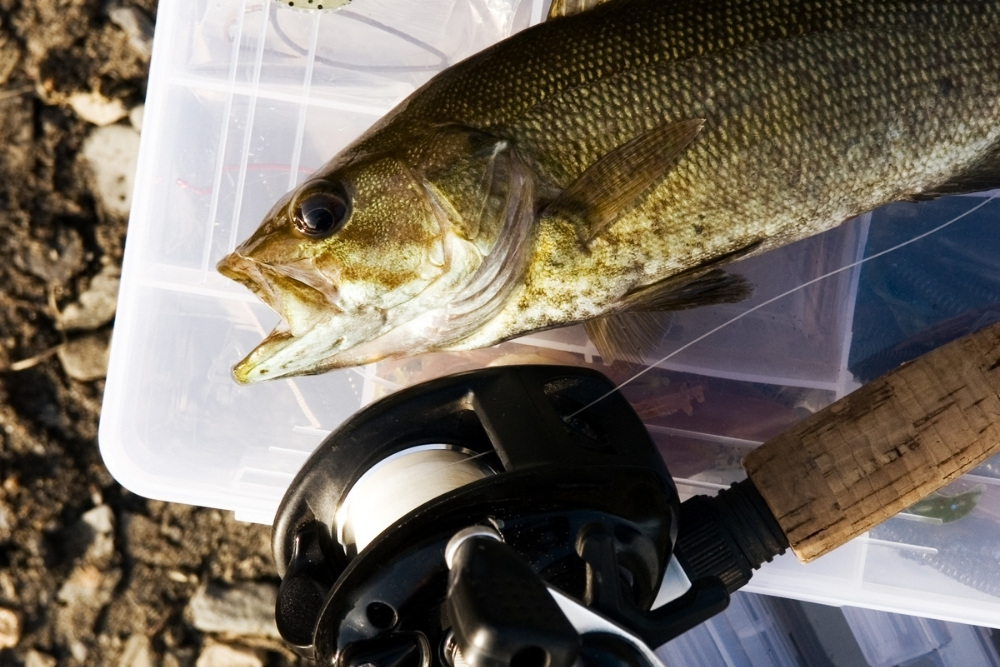
Monofilament Line
Often referred to as just ‘mono,’ monofilament line is an incredibly simple cord design typically crafted with a single type of fiber or plastic, hence the name.
Versatile and inexpensive to produce due to its basic composition, the monofilament line is an incredibly popular option. However, it’s not quite as ubiquitous in fishing communities as it was a few decades ago.
Generally speaking, it’s one of the thinnest lines, but it can still be bought in a wide range of diameters and an array of different colors and test strengths tools.
The defining factor of the monofilament line is the ability to stretch 25%+ beyond its resting length, which can be incredibly helpful in a lot of situations, especially for beginners. Say, for example, you set the hook too hard.
The stretch in the line offers just enough give to prevent the hook from tearing a hole in the fish’s mouth. If you’re just getting started and want a nice ‘workable’ line to practice casting and retrieving, you absolutely can’t go wrong with monofilament.
What makes monofilament a good choice for bass fishing is its almost imperceptible line presence in the water. Fish simply don’t often notice it, focusing instead on the lure.
Areas in which this type of line falls short are strength and deep water fishing. It’s just not heavy enough to give you full articulation past a certain depth.
Braided Line
Historically, the braided line was made from natural fibers such as linen or cotton, and it was incredibly popular in both the fishing industry and sport fishing. Nowadays, it’s typically composed of synthetic polymers.
Unlike monofilament lines, it exhibits little to no stretch and features incredibly high knot strength and power.
As the braided line has such a high test strength, it’s often paired with weighted lures for punching mats, a technique used to penetrate thick grasses and another substrate on the bed, a common spawning location of bass.
Braided line also has a significant surface area enabling it to float well on the surface of the water, making it the weapon of choice when casting out with walking baits or things like frog lures.
Lastly, due to the strength of the braided line, a smaller diameter can be threaded, meaning a lighter, smaller rod can be used, giving you more articulation to execute techniques and make the catch.
Fluorocarbon Line
Made from a mixture of melted down synthetic polymers and formed via extrusion, a process that involves threading the polymer cocktail through tiny die pallets, fluorocarbon is the most modern of the three mainline types. Monoline is also created using the extrusion technique.
Fluorocarbon line can be even thinner than monoline, making it nigh on indetectable in the water, ensuring the fish aren’t spooked.
Fluorocarbons can have such a small diameter that light refraction through the line is minimized, adding to its invisibility. It’s considered a sensitive line, too, meaning it’s articulate, allowing you to hone your fine fishing skills.
As great out of the water as it is in it, fluorocarbon line doesn’t degrade nearly as fast as the other two types, making it a favorite for anglers who like to stock up or those that don’t get a chance to hit the water all that often.
Fluorocarbon can also be instrumental for crank fishing, where you reel the lure through the water from far and deep, a technique known to increase the chances of snagging large bass.
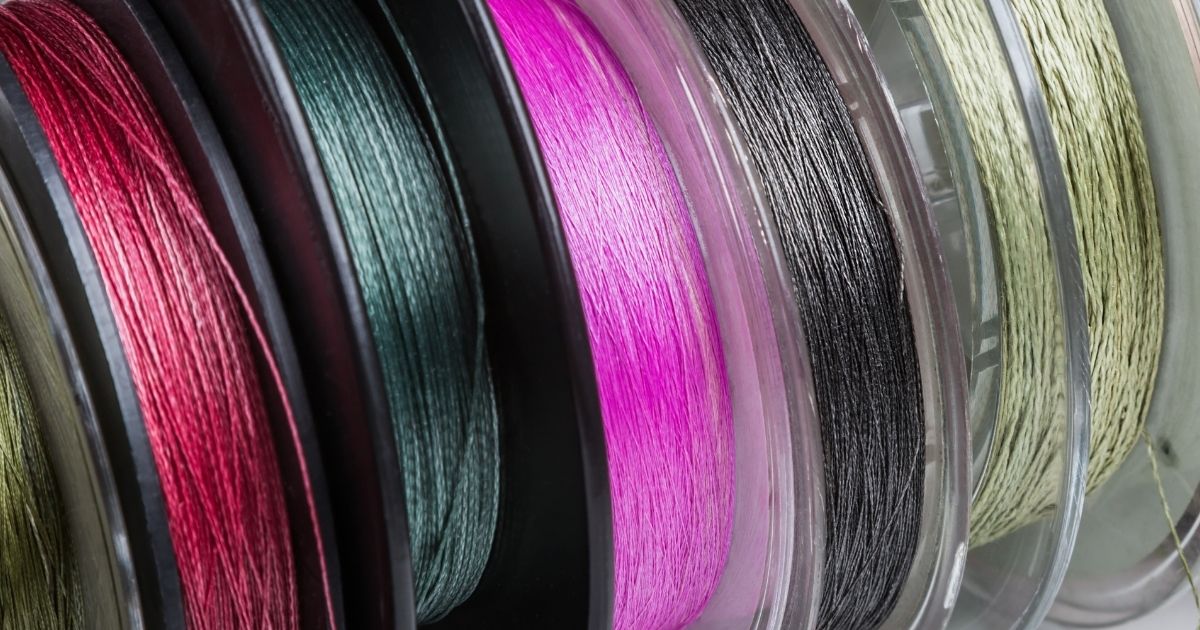
Choose the best monofilament, fluorocarbon, or braided line for bass fishing.
The Best Fishing Line for Bass in 2022 FAQs
We’ve just about covered all the basics now, but fishing is a complex and deep sport, so let’s peer beneath the surface with some informative, frequently asked questions.
What is fishing line memory?
Although this term makes it sound like fishing lines can be sentient somehow, it’s not quite as exciting as that, but it is an essential occurrence to be aware of.
Line memory refers to the deformation of the line while on the spool. Whereas the fishing line goes on straight, it comes off the reel kinked or curled because it ‘remembers’ the coil.
Line memory mostly occurs in small diameter, lightweight lines. Hampering cast distance and increasing the chances of tangles and snags can affect your performance and catch rate.
Line memory is almost unavoidable, but a few key maintenance bits can reduce the negative effects. Stretching your line is an effective method, as is changing your line regularly – the longer it sits on the spool, the more it will ‘remember.’
Another way you can reduce line memory is by keeping your rod and line at a stable and mild temperature. Some witch doctor anglers even suggest boiling your line like spaghetti, but that’s not proven to work.
Higher quality lines are designed to reduce memory, so spending a little extra cash can help.
What is the abrasion resistance of a fishing line?
Abrasion resistance is its ability to maintain structural integrity when in contact with abrasive surfaces such as rocks or other rough objects hidden in the water.
A line with high abrasion tolerance is essential in rugged waters as it’s common for your line to make contact with a lot of surfaces as a fish darts and thrashes, trying to pull away from the lure.
If a line can’t handle contact with the friction-bearing object, it will snap, and your catch will be gone for good.
Unfortunately, there is no universal way of measuring abrasion resistance. Manufacturers are employing different means of testing, which makes choosing a strong line pretty difficult. The only way to be sure is to do your testing by pulling the line taught and running it over a rock.
Everything about a line’s construction affects its abrasion resistance. The materials, the diameter, and the tensile strength all count towards the final product.
The braided line tends to be the most capable of surviving rugged terrain as it can be quite hard and normally has a larger diameter than other line types.
Lines with high levels of abrasion resistance aren’t always necessary. If you’re fishing in clear waters with fairly simple or soft bed structure and no tide, the chances of snagging on a rough surface are pretty low.
On the other hand, if you’re trying your luck in a particularly rocky section of a river, load up your braided line. You’re going to need it!
What does the pound test of a line mean?
The pound test of a line refers to its strength when holding weight, specifically the point at which it will break. Higher test strength lines are best when you’re gunning for larger, heavier fish.
Rods have a stated pound test capacity that corresponds with their line test curve. Exceeding these limits may, in some cases, damage your rod.
What’s the best pound test line for fishing?
Bass are mostly small to medium-sized fish, so you’ll need a line with a test strength of 8 or above. That said, the world record bass catch weighed in at 22lbs 4oz, which you’d need a significantly stronger test for.
What is the best bait for bass?
The beautiful thing about bass fishing is that they’re not fussy eaters, they’re just hungry, and you can entice them with almost any kind of bait. Sprats (small fresh fish) are good, but fish strips are great too. Herring, mackerel, and even squid are particular favorites of a lot of bass anglers.
They’re also known to have a hankering for de-clawed hermit crabs, sand eels, and shrimps. With bass, pretty much anything goes, so feel free to get adventurous with your bait.
Does line color matter?
The impact line color has in various scenarios is a hotly debated topic. The one thing most are in agreement on is that with braided lines, it doesn’t matter because they’re visible regardless of color.
When it comes to thinner lines, research is ongoing to ascertain whether fish can see it at all, but are there reasons other than possibly spooking fish we should care about line color? The answer is yes!
You may want to align your color choice with natural light. For example, bright color at night will give you good visuals of the cast via a small lamp. During the day, this isn’t necessary, so a mild color or transparent line will suffice.
In terms of visibility, color doesn’t matter during topwater fishing as the line doesn’t sink, but yellow is often preferred as its striking contrast with the water makes a bite much more noticeable.
Some theories gaining traction include matching the line color with the shade of water to hide the line or that red signifies blood and draws fish in. Another states that pink is hidden at depth, eluding detection by fish, but it has high visibility above water, offering decent visuals on your cast.
If you’re a beginner, our advice is to stick with a transparent line for now, and as you learn and grow as an angler, you’ll make your discoveries about the impact of colored lines.
What’s the best season for bass fishing?
You can successfully fish for bass year-round, but the best times of year to give it a go are generally thought to be Spring and Fall. If you’re not having any luck, try casting out at dawn or dusk as bass tend to hunt in low light conditions, meaning they’re more likely to have a nibble on your bait.
Summary of the 5 Best Fishing Line for Bass in 2022
There you have it, folks, five of the best fishing lines for pulling in that prize bass you’ve been chasing. They say a poor workman blames his tools, but the tools can make or break a catch in fishing. Follow the link if you’d like more detail on the differences between monofilament, fluorocarbon, and braided fishing lines.
Finding the right tools can be difficult as the market is so saturated at the minute. Still, as long as you pay attention to your surroundings and consider the weather conditions, you should be able to use what you’ve learned here to pick out a line that’s fit for purpose and increase your catch rate exponentially! Good luck.



